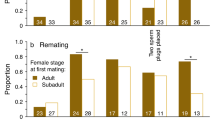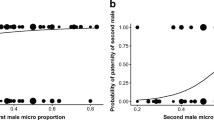Abstract
We tested the hypothesis that primate female copulation calls are a form of postcopulatory female choice. We collected data on female sexual swellings, sexual and agonistic behavior, copulation calls and postcopulatory behavioral interactions in a multimale-multifemale captive group of Guinea baboons over a 3-mo period. Males copulated with only a few females, and females copulated with only 1 or 2 different males in the group, suggesting a harem-like mating system similar to that of hamadryas and gelada baboons. Female copulations were most likely to occur at peak sexual swellings and male copulatory success was accounted for by dominance rank and age. Variation in female tendencies to call after copulation is best explained by the copulatory success of the male with which each female copulated the most and by the number of copulating partners. The findings are consistent with predictions that calls are likely to be associated with copulation with preferred males and the risk of sperm competition. The prediction that copulation calls increased the probability of postcopulatory mate guarding is also supported. Taken together, the findings suggest that female copulation calls may play an important role in postcopulatory sexual selection and in particular in the expression of postcopulatory female choice in primate species in which females have little opportunity to choose their mates or female mate choice is costly or both.
Similar content being viewed by others
References
Aich, H., Moos-Heilen, R., and Zimmerman, E. (1990). Vocalizations of adult gelada baboons (Theropitecus gelada): acoustic structure and behavioral context. Folia Primatol. 55: 109–132.
Anderson, J. R., and McGrew, W. C. (1984). Guinea baboons (Papio papio) at a sleeping site. (Am. J. Primatol.) 6: 1–14.
Andersson, M. (1994). Sexual Selection. Princeton University Press, Princeton, NJ.
Bercovitch, F. B. (1989). Body size, sperm competition, and determinants of reproductive success in male savanna baboons. Evolution 43: 1507–1521.
Bert, T., Ayats, H., Martino, A., and Collomb, H. (1967). Note sur l’organisation de la vigilance sociale chez le babouin Papio papio. Folia Primatol. 6: 44–47.
Bielert, C., and Van der Walt, L. A. (1982). Male chacma baboon (Papio ursinus) sexual arousal: mediation by visual cues from female conspecifics. (Psychoneuroendocrinology) 7: 31–48.
Birkhead, T. R., and Pizzari, T. (2002). Postcopulatory sexual selection. Nature Rev. Genetics 3: 262–272.
Boese, G. K. (1975). Social behavior and ecological considerations of West African baboons (Papio papio). In Tuttle, R. H. (ed.), Socioecology and Psychology of Primates. Mouton, The Hague, pp. 205–230.
Byrne, R. W. (1981). Distance vocalisations of Guinea baboons (Papio papio) in Senegal: An analysis of function. Behaviour 78: 283–313.
Cowlishaw, G., and O’Connell, S. M. (1996). Male-male competition, paternity certainty and copulation calls in female baboons. Anim. Behav. 51: 235–238.
Dixson, A. F. (1983). Observations on the evolution and behavioral significance of “sexual skin” in female primates. Adv. Study Behav. 13: 63–106.
Dixson, A. F. (1998). Primate Sexuality: Comparative Studies of the Prosimians, Monkeys, Apes, and Human Beings. Oxford University Press, Oxford.
Domb, L. G., and Pagel, M. (2001). Sexual swellings advertise female quality in wild baboons. Nature 410: 204–206.
Dunbar, R. I. M., and Dunbar, P. (1975). Social dynamics of gelada baboons. Contributions to Primatology, 6: 1–157. Karger, Basel.
Dunbar, R. I. M., and Nathan, M. F. (1972). Social organization of the Guinea baboon, Papio papio. Folia Primatol. 17: 321–334.
Gauthier, C. (1999). Reproductive parameters and paracallosal skin color changes in captive female Guinea baboons, Papio papio. Am. J. Primatol. 47: 67–74.
Girolami, L., and Bielert, C. (1987). Female perineal swelling and its effects on male sexual arousal: An apparent sexual releaser in the chacma baboon (Papio ursinus). Int. J. Primatol. 8: 651–661.
Gomendio, M., Harcourt, A. H., and Roldan, E. R. S. (1998). Sperm competition in mammals. In Birkhead, T. R., and Moller, A. P. (eds.), Sperm Competition and Sexual Selection. Academic Press, San Diego: pp. 667–755.
Hamilton, W. J., and Arrowood, P. C. (1978). Copulatory vocalizations of chacma baboons (Papio ursinus), gibbons (Hylobates lar), and humans (Homo sapiens). Science 2001: 405–1409.
Harcourt, A. H., Harvey, P. H., Larson, S. G., and Short, R. V. (1981). Testis weight, body weight, and breeding system in primates. Nature 293: 55–57.
Henzi, S. P. (1996). Copulation calls and paternity in chacma baboons. Anim. Behav. 51: 233–234.
Jolly, C. J., and Phillips-Conroy, J. E. (2003). Testicular size, mating system, and maturation schedule in wild anubis and hamadryas baboons. Int. J. Primatol. 24: 125–142.
Jones, A. G. (2002). The evolution of alternative cryptic female choice strategies in age-structured populations. Evolution 56: 2530–2536.
Kummer, H. (1968). Social Organization of Hamadryas Baboons. University of Chicago Press, Chicago.
Maestripieri, D., and Roney, J. R. (2005). Primate copulation calls and post-copulatory female choice. Behavioral Ecology 16: 106–113.
Manson, J. H. (1997). Primate consortships. A critical review. Curr. Anthropol. 38: 353–374.
Melnick, D. J., and Pearl, M. C. (1987). Cercopithecines in multimale groups: genetic diversity and population structure. In Smuts, B. B., Cheney, D. L., Seyfarth, R. M., Wrangham, R. W., and Struhsaker, T. T. (eds.), Primate Societies. University of Chicago Press, Chicago, pp. 121–134.
Moos-Heilen, R., and Sossinka, R. (1990). The influence of oestrus on the vocalization of female gelada baboons (Theropithecus gelada). Ethology 84: 35–46.
Nunn, C. L. (1999). The evolution of exaggerated sexual swellings in primates and the graded-signal hypothesis. Anim. Behav. 58: 229–246.
O’Connell, S. M., and Cowlishaw, G. (1994). Infanticide avoidance, sperm competition and mate choice: The function of copulation calls in female baboons. Anim. Behav. 48: 687–694.
Oda, R., and Masataka, N. (1992). Functional significance of female Japanese macaque copulatory calls. Folia Primatol. 58: 146–149.
Paul, A. (2002). Sexual selection and mate choice. Int. J. Primatol. 23: 877–904.
Saayman, G. S. (1970). The menstrual cycle and sexual behaviour in a troop of free-ranging chacma baboons (Papio ursinus). (Folia Primatol.) 12: 81–110.
Semple, S. (1998). The function of Barbary macaque copulation calls. Proc. R. Soc. Lond. B 265: 287–291.
Semple, S. (2001). Individuality and male discrimination of female copulation calls in the yellow baboon. Anim. Behav. 61: 1023–1028.
Semple, S., and McComb, K. (2000). Perception of female reproductive state from vocal cues in a mammal species. Proc. R. Soc. Lond. B 264: 707–712.
Semple, S., McComb, K., Alberts, S., and Altmann, J. (2002). Information content of copulation calls in yellow baboons. (Am. J. Primatol.) 56: 43–56.
Shaik, A. A., Celaya, C. L., Gomez, I., and Shaikh, S. A. (1982). Temporal relationship of hormonal peaks to ovulation and sex skin deturgescence. Primates 23: 444–452.
Smuts, B. B., and Smuts, R. W. (1993). Male aggression and sexual coercion of females in nonhuman primates and other mammals: Evidence and theoretical implications. Adv. Study Behav. 22: 1–63.
Stammbach, E. (1987). Desert, forest, and montane baboons: Multilevel societies. In Smuts, B. B., Cheney, D. L., Seyfarth, R. M., Wrangham, R. W., and Struhsaker, T. T. (eds.), Primate Societies. University of Chicago Press, Chicago, pp. 112–120.
Swedell, L., and Saunders, J. (2003). Female reproductive strategies in hamadryas baboons: paternity certainty, infanticide avoidance, and copulation calls.—Paper presented at the Annual Meeting of the American Association for Physical Anthropology, Tempe, AZ.
Todt, D., Hammerschmidt, K., Ansorge, V., and Fischer, J. (1995). The vocal behavior of Barbary macaques (Macaca sylvanus): Call features and their performance in infants and adults. In Zimmermann, E., Newman, J. D., and Jurgens, U. (eds.), Current Topics in Primate Vocal Communication. Plenum Press, New York, pp. 141–160.
Zinner, D., and Deschner, T. (2000). Sexual swellings in female hamadryas baboons after male take-overs: “Deceptive” swellings as a possible female counter-strategy against infanticide. Am. J. Primatol. 52: 157–168.
Author information
Authors and Affiliations
Corresponding author
Rights and permissions
About this article
Cite this article
Maestripieri, D., Leoni, M., Raza, S.S. et al. Female Copulation Calls in Guinea Baboons: Evidence for Postcopulatory Female Choice?. Int J Primatol 26, 737–758 (2005). https://doi.org/10.1007/s10764-005-5306-6
Received:
Revised:
Accepted:
Issue Date:
DOI: https://doi.org/10.1007/s10764-005-5306-6




